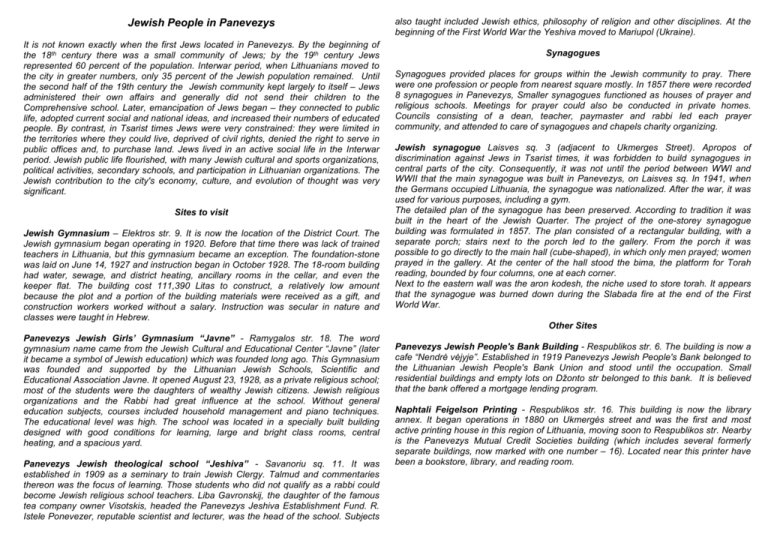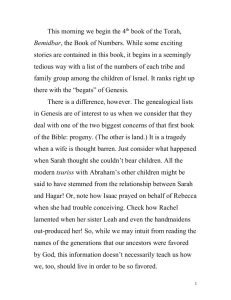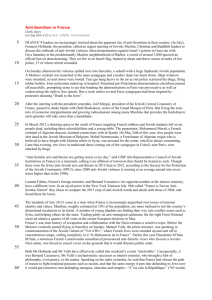Jewish People in Panevezys
advertisement

Jewish People in Panevezys It is not known exactly when the first Jews located in Panevezys. By the beginning of the 18th century there was a small community of Jews; by the 19th century Jews represented 60 percent of the population. Interwar period, when Lithuanians moved to the city in greater numbers, only 35 percent of the Jewish population remained. Until the second half of the 19th century the Jewish community kept largely to itself – Jews administered their own affairs and generally did not send their children to the Comprehensive school. Later, emancipation of Jews began – they connected to public life, adopted current social and national ideas, and increased their numbers of educated people. By contrast, in Tsarist times Jews were very constrained: they were limited in the territories where they could live, deprived of civil rights, denied the right to serve in public offices and, to purchase land. Jews lived in an active social life in the Interwar period. Jewish public life flourished, with many Jewish cultural and sports organizations, political activities, secondary schools, and participation in Lithuanian organizations. The Jewish contribution to the city's economy, culture, and evolution of thought was very significant. Sites to visit Jewish Gymnasium – Elektros str. 9. It is now the location of the District Court. The Jewish gymnasium began operating in 1920. Before that time there was lack of trained teachers in Lithuania, but this gymnasium became an exception. The foundation-stone was laid on June 14, 1927 and instruction began in October 1928. The 18-room building had water, sewage, and district heating, ancillary rooms in the cellar, and even the keeper flat. The building cost 111,390 Litas to construct, a relatively low amount because the plot and a portion of the building materials were received as a gift, and construction workers worked without a salary. Instruction was secular in nature and classes were taught in Hebrew. also taught included Jewish ethics, philosophy of religion and other disciplines. At the beginning of the First World War the Yeshiva moved to Mariupol (Ukraine). Synagogues Synagogues provided places for groups within the Jewish community to pray. There were one profession or people from nearest square mostly. In 1857 there were recorded 8 synagogues in Panevezys, Smaller synagogues functioned as houses of prayer and religious schools. Meetings for prayer could also be conducted in private homes. Councils consisting of a dean, teacher, paymaster and rabbi led each prayer community, and attended to care of synagogues and chapels charity organizing. Jewish synagogue Laisves sq. 3 (adjacent to Ukmerges Street). Apropos of discrimination against Jews in Tsarist times, it was forbidden to build synagogues in central parts of the city. Consequently, it was not until the period between WWI and WWII that the main synagogue was built in Panevezys, on Laisves sq. In 1941, when the Germans occupied Lithuania, the synagogue was nationalized. After the war, it was used for various purposes, including a gym. The detailed plan of the synagogue has been preserved. According to tradition it was built in the heart of the Jewish Quarter. The project of the one-storey synagogue building was formulated in 1857. The plan consisted of a rectangular building, with a separate porch; stairs next to the porch led to the gallery. From the porch it was possible to go directly to the main hall (cube-shaped), in which only men prayed; women prayed in the gallery. At the center of the hall stood the bima, the platform for Torah reading, bounded by four columns, one at each corner. Next to the eastern wall was the aron kodesh, the niche used to store torah. It appears that the synagogue was burned down during the Slabada fire at the end of the First World War. Other Sites Panevezys Jewish Girls’ Gymnasium “Javne” - Ramygalos str. 18. The word gymnasium name came from the Jewish Cultural and Educational Center “Javne” (later it became a symbol of Jewish education) which was founded long ago. This Gymnasium was founded and supported by the Lithuanian Jewish Schools, Scientific and Educational Association Javne. It opened August 23, 1928, as a private religious school; most of the students were the daughters of wealthy Jewish citizens. Jewish religious organizations and the Rabbi had great influence at the school. Without general education subjects, courses included household management and piano techniques. The educational level was high. The school was located in a specially built building designed with good conditions for learning, large and bright class rooms, central heating, and a spacious yard. Panevezys Jewish theological school “Jeshiva” - Savanoriu sq. 11. It was established in 1909 as a seminary to train Jewish Clergy. Talmud and commentaries thereon was the focus of learning. Those students who did not qualify as a rabbi could become Jewish religious school teachers. Liba Gavronskij, the daughter of the famous tea company owner Visotskis, headed the Panevezys Jeshiva Establishment Fund. R. Istele Ponevezer, reputable scientist and lecturer, was the head of the school. Subjects Panevezys Jewish People's Bank Building - Respublikos str. 6. The building is now a cafe “Nendrė vėjyje”. Established in 1919 Panevezys Jewish People's Bank belonged to the Lithuanian Jewish People's Bank Union and stood until the occupation. Small residential buildings and empty lots on Džonto str belonged to this bank. It is believed that the bank offered a mortgage lending program. Naphtali Feigelson Printing - Respublikos str. 16. This building is now the library annex. It began operations in 1880 on Ukmergės street and was the first and most active printing house in this region of Lithuania, moving soon to Respublikos str. Nearby is the Panevezys Mutual Credit Societies building (which includes several formerly separate buildings, now marked with one number – 16). Located near this printer have been a bookstore, library, and reading room.








